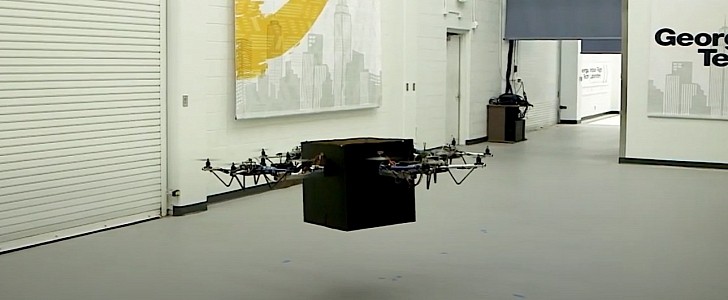Having an item you ordered online delivered by means of a drone is no longer something that can only be found in science-fiction literature. Sure, such a thing is not happening yet on a large scale, but we’re getting there.
Generally speaking, delivery by means of drones is a limited affair, as these flying machines are capable of only carrying so much weight. How much, you ask? According to the Georgia Institute of Technology (Georgia Tech), that would be something in the vicinity of five pounds or less (2.2 kg). So, if you plan to ship something that weighs more than that, you’d still have to rely on good, old-fashioned human power.
Or, you could turn to collaborative drones. What are those? Individual drones, only somehow made to work together to lift heavier objects.
A team from Georgia Tech is already looking into how this could turn into reality, and has already come up with an adaptive control algorithm that allows drones to work together.
For the purposes of testing the algorithm, the team had only four drones lift a cube-shaped object that weighs 12 pounds/5.4 kg (more in the video below), but we’re told the software could be adapted to allow a virtually unlimited number of drones to team up.
That opens the doors to a host of other applications, that go far beyond the scope of having goods delivered. They could be used for supplying advanced military forces, for instance, or help people that are in a tight spot following a natural disaster.
“That would distribute a big lifting capability in smaller packages, which equates to small drones that could be used to team up,” said in a statement Jonathan Rogers, the Lockheed Martin Associate Professor of Avionics Integration in Georgia Tech’s Daniel Guggenheim School of Aerospace Engineering.
“Putting small drones together would allow them to do bigger things than they could do individually.”
The team estimates their idea could be ready for implementation in about five years.
Or, you could turn to collaborative drones. What are those? Individual drones, only somehow made to work together to lift heavier objects.
A team from Georgia Tech is already looking into how this could turn into reality, and has already come up with an adaptive control algorithm that allows drones to work together.
For the purposes of testing the algorithm, the team had only four drones lift a cube-shaped object that weighs 12 pounds/5.4 kg (more in the video below), but we’re told the software could be adapted to allow a virtually unlimited number of drones to team up.
That opens the doors to a host of other applications, that go far beyond the scope of having goods delivered. They could be used for supplying advanced military forces, for instance, or help people that are in a tight spot following a natural disaster.
“That would distribute a big lifting capability in smaller packages, which equates to small drones that could be used to team up,” said in a statement Jonathan Rogers, the Lockheed Martin Associate Professor of Avionics Integration in Georgia Tech’s Daniel Guggenheim School of Aerospace Engineering.
“Putting small drones together would allow them to do bigger things than they could do individually.”
The team estimates their idea could be ready for implementation in about five years.


